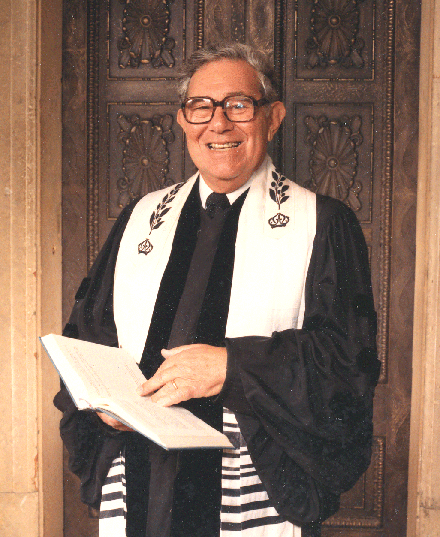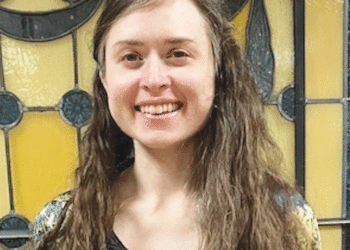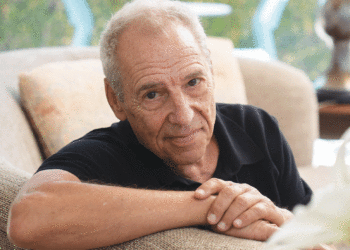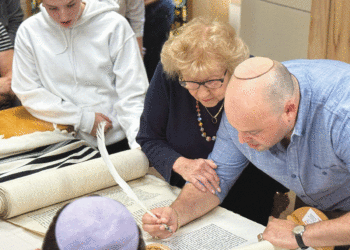By MORDECAI SPECKTOR
The prelude and recessional music at the Oct. 20 funeral service of Rabbi Max A. Shapiro was Louis Armstrong’s “What a Wonderful World.” The song — with its lyrics about “skies of blue, clouds of white / Bright blessed days, dark sacred nights” — expresses something of the upbeat spirit of the revered rabbi who is being remembered.
Rabbi Shapiro, who served the congregants of Temple of Israel in Minneapolis for 30 years, and led efforts to promote racial equality and interfaith understanding, died Oct. 16 in his Minnetonka home. He was 92.
Playing “What a Wonderful World,” at the beginning and at the end of the funeral, was Rabbi Shapiro’s wish, the way he wanted to frame the ceremony, said Rabbi Marcia Zimmerman, senior rabbi of Temple Israel.
“He was the eternal optimist,” she said, “He never saw a door closed, he always saw another opportunity…. He always saw things in a positive light.”
 Rabbi Max A. Shapiro (Photo: Courtesy of Temple Israel)
Rabbi Max A. Shapiro (Photo: Courtesy of Temple Israel)
At the funeral service, Shapiro’s grandson, Zachary Rae, read an eloquent and moving tribute to family members penned by the late rabbi at around the time of his 90th birthday, which was the occasion for a major celebration by Temple Israel congregants.
Rabbi Zimmerman and Rabbi Barry Cytron, who succeeded Shapiro as director of the Jay Phillips Center for Jewish-Christian Learning, also delivered eulogies at the funeral.
Cytron mentioned that Shapiro was an exemplary student at Boston Latin School; but he was denied admission to Harvard University, because the Ivy League school had filled its quota for Jewish students. Early in the previous century, Jews ran into such restrictions in many areas of American society.
“I think that was a formative influence in his fight against injustice,” said Rabbi Barry Cytron, regarding Shapiro’s exclusion from his first-choice in higher learning. “He knew it from the [Jewish] tradition and he knew it from inside himself.”
Despite his personal experience of discrimination, Shapiro was “constitutionally incapable of becoming embittered,” Cytron noted, during his eulogy at the rabbi’s funeral on Tuesday at Temple Israel. “His outlook on life, the sweetness of his soul, and the good fortune of arriving in a Jewish community, which had already developed its own parallel universe of institutions, was the perfect match.”
Born Jan. 31, 1917, in Massachusetts, Shapiro attended Clark University, in Worcester, Mass.; and then earned a master’s degree in education from Boston Teacher’s College. He served as a chaplain at Lawson General Hospital, in Atlanta, Ga., during World War II, an experience that motivated him to enter the rabbinate. From 1944-1946, Shapiro served in the Middle East, and contributed to the writing of a history of the U.S. Air Force.
In 1950, Shapiro was admitted to Hebrew Union College-Jewish Institute of Religion, in Cincinnati, Ohio, and completed the six-year course in five years. Following his ordination, in 1955, he took the post of assistant rabbi at Temple Israel. In Minnesota, he became the first adjunct professor of Jewish Studies at United Theological Seminary in New Brighton. Shapiro also was a visiting professor for more than 20 years at Hamline University’s Department of Religion and Philosophy. He was awarded a doctorate in education from University of Cincinnati in 1960.
Shapiro became Temple Israel’s senior rabbi in 1963, following the retirement of Rabbi Albert G. Minda. A history of Temple Israel, which can be found on the congregation’s Web site, states that Rabbi Shapiro innovated in a number of ways, including “reading Torah on Friday evenings, the Bar and Bat Mitzva program, and liturgical tracts to modernize the Sabbath and High Holy Day services. He increased the role of women in worship services and expanded the educational programs begun by Rabbi Minda.”
In the larger community, Rabbi Shapiro co-founded the Center for Jewish-Christian Learning at St. Thomas, in 1985, with the late Msgr. Terrence J. Murphy, who was president of University of St. Thomas from 1966 to 1991. He also served as the center’s director until his retirement in 1996.
The center merged with Saint John’s University’s Jay Phillips Chair in Jewish Studies, and became the Jay Phillips Center for Jewish-Christian Learning in 1996. In February, the program expanded its mission to promote interfaith learning among adherents of various religions and became the Jay Phillips Center for Interfaith Learning.
Karen Schierman, associate director of the center for the past 18 years, worked closely with Shapiro, and said that relationship was “the highlight” of her career. In a remembrance on the Web site of the Jay Phillips Center for Interfaith Learning, she commented that the center was “unmatched in the nation” during Shapiro’s tenure as founding director and “courageous leader,” hosting Abba Eban, Elie Wiesel, Rabbi Harold Kushner, Joseph Cardinal Bernardin, “and so many more stimulating and provocative speakers.”
Schierman remembered Shapiro as a “vibrant, amazingly intelligent, kind, thoughtful and loving man.”
Shapiro also served as a catalyst for local civil rights activities, in an era when the idea of a black president was a pipe dream. He helped create the Neighborhood Involvement Program (NIP), working with local clergy, businesses and civic groups to provide health care and social services to families living in poverty.
Rabbi Zimmerman said that during the social upheaval in the 1960s, Shapiro’s response was “to create an organization that gave people their basic needs and their dignity. That was really what he did all the time.” Even when he was 90 years old, and most of his peers had passed away, Zimmerman said he would call to get her involved in helping individuals with particular needs.
The late spiritual leader of Temple Israel was always “looking out for those who are in need and lending a hand, and making sure our world was just,” said Temple Israel’s first female rabbi.
Under Shapiro’s leadership, Temple Israel grew from 750 families, in 1955, to more than 1,850 families when he retired as senior rabbi in 1985.
As the congregation’s membership grew, Rabbi Shapiro displayed a remarkable talent for remembering everyone’s name, and the names of their children and grandchildren. Cytron commented that Shaprio “combined a quite powerful ability to be a public figure, with an incredible facility for connecting on a personal level.”
In his eulogy on Tuesday, Cytron mentioned that Oak Ridge Country Club was a “second sanctuary” for Shapiro. Cytron said: “Each time I would be with him there, the unparalleled greeting he received was breathtaking, the way people of all generations rose at his entrance, the manner in which contemporaries and congregants alike, of all ages, responded to the sheer radiance of his presence to welcome him home.”
At the shiva on Wednesday at Temple Israel, Rabbi Zimmerman mentioned that Shapiro was the first of Temple Israel’s rabbis to wear bathing trunks and swim in the Oak Ridge pool. “He really broke down the traditional barriers; it was the time he lived in, but he did it with an incredible grace and dignity,” she told the Jewish World.
Shapiro received many honors during his lifetime, including the International Franciscan Award from the Franciscan religious order, the Humanitarian Award from the National Conference of Christians and Jews, the Shalom Award from the University of St. Thomas, and the Pax Christi Award from St. John’s University in Collegeville, Minn. In 1990, St. Thomas presented him with an honorary doctor of humane letters degree.
Rabbi Shapiro is preceded in death by his wife, Bernice (1984); his parents, Samuel and Clara; two brothers, Dr. Joseph and Rabbi Robert; sister, Sylvia Slocum; sisters-in-law Charlotte and Harriet; and brother-in-law Michael Slocum. He is survived by his wife, Abby Lou Evans; his daughter Susan, son-in-law, Dan Rae; son Steven; and his grandson Zachary. He is also survived by Evans’ children and grandchildren; and nieces and nephews.
(Editor’s note: The American Jewish World will publish a remembrance of Rabbi Max A. Shapiro in the Oct. 30 edition.)









 Rabbi Max A. Shapiro (Photo: Courtesy of Temple Israel)
Rabbi Max A. Shapiro (Photo: Courtesy of Temple Israel)









